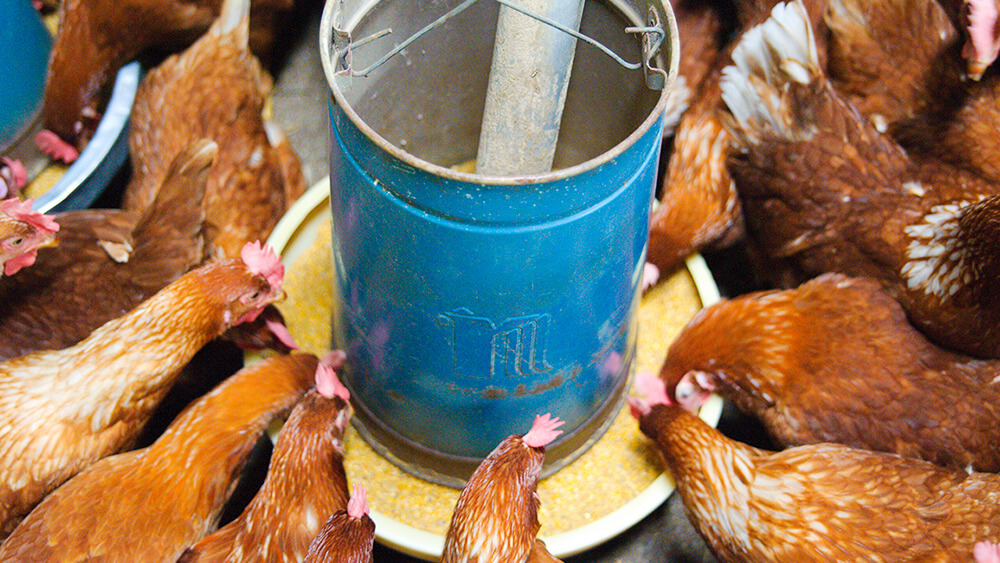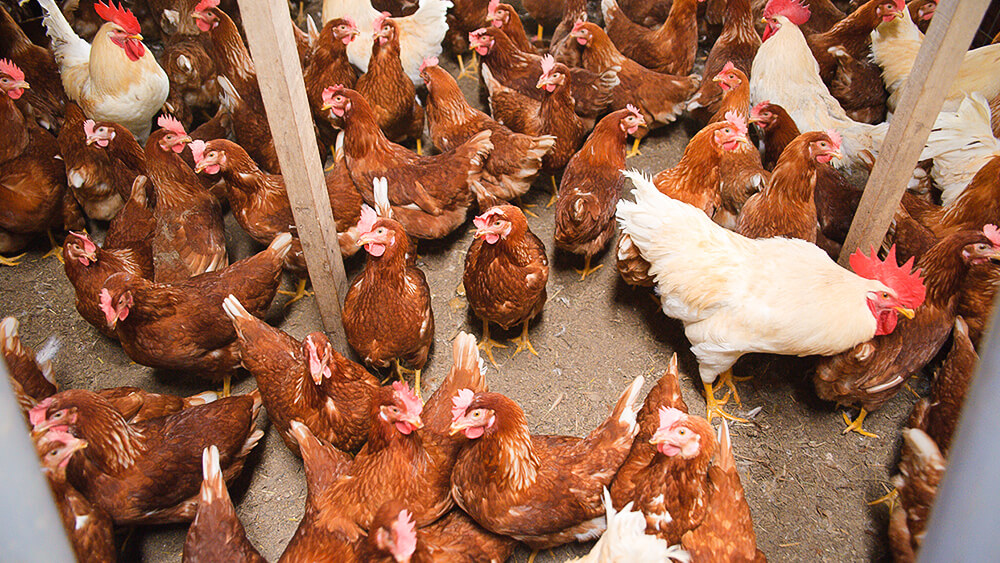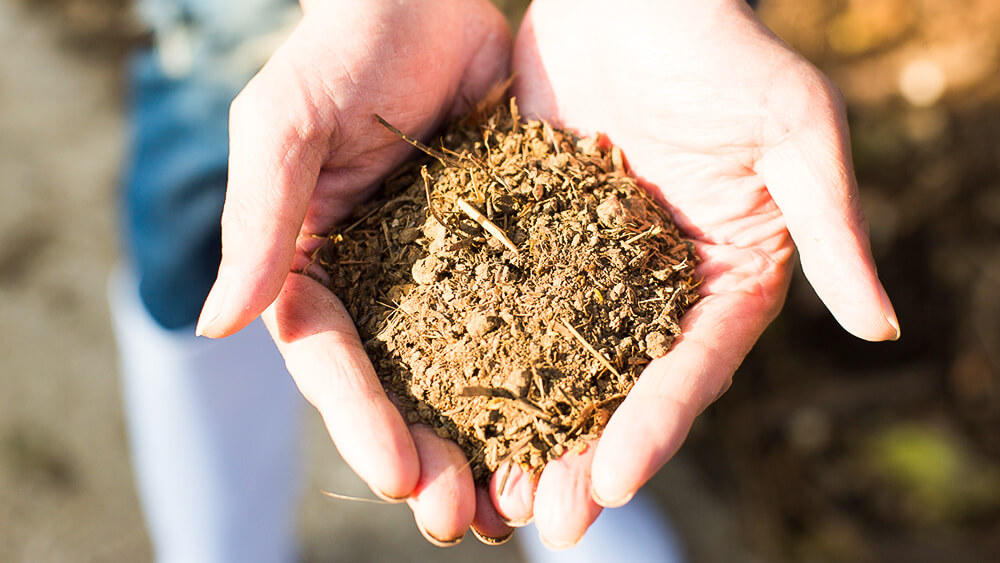About Eggs & Vegetables
About Eggs
We harness the power of microbes with free range chicken farming.
We provide a daily truckload of greens and herbs and clean water through perforated pipes, and we leave the chickens’ dietary mix up to the chickens themselves.
The floor of the chicken coup is covered in a layer of composting chicken droppings, creating a surface like forest humus.
In this environment, there’s no smell, and the chickens can produce healthy eggs that can even be eaten raw.
A chick that was dying from overmedication stood up.
In 1980, I began poultry farming with my older brother. However, no sooner had we introduced 25,000 new chicks, when 100-200 of them died within a day. Upon investigating this, we discovered Escherichia coli and Staphylococcus aureus. At the time, I had just graduated with a major in animal feed, and all I knew how to do was to treat bacterial infections with medicine. So we used a disinfectant twice daily and antibiotics. After using the antibiotic for a week, the chicks stopped dying. But after about 3 years, the antibiotic lost its effectiveness. The next antibiotic lasted another 3 years, and the one after that only lasted a single year. The concentration of antibiotics in the chickens’ blood increased, and while it prevented infections, the chicks became sallow and weak. About 100-200 chicks became anemic and their bodies began to rot. Unable to treat all of them at once, we left them in the banana field overnight. Later, we noticed that chicks who didn’t last half a day in the cage were surviving in the fields. Without feed, medicine, or disinfection, these chicks were standing up and gaining vitality.

Leave the chickens' diet to the chickens.
We became interested as to what the chicks left in the banana field had been eating, so we performed an autopsy. However, inside the chick’s stomach, we only found earth, grass, and dead leaves. In other words, nothing considered to be rich, wholesome feed. So, we decided to simply recreate that environment inside our chicken coups. That was the beginning of our current feed system. First, we tried mixing dead leaves and humus into the feed. Not only did the chickens eat this, but they became healthier. Then, an acquaintance gave us a Awabi mushroom bed (mushrooms can’t be grown with anything artificial like antibiotics or preservatives). We crushed the mushrooms into powder and fed it to the chickens, which further improved their health. That’s when we started our system of letting the chickens decide on their own dietary mix, and over the next 5 years, we came up with our own original blend (a combination of corn, mugwort powder, seaweed power, wood vinegar, oyster shells, and mountain soil, with the addition of fermented organic matter containing effective microorganisms). Mycelium is strong in fiber, so we did some research on whether there was a bacterium that could break down the fiber. After trying several types of micro organic material, we eventually settled on an effective microorganism blend of lactic-acid bacilli, yeast, and photosynthetic bacteria. This allows us to simply and safely create fermented feed any time we need it. But even though we provide the chickens with fermented feed and a truckload of greens ever day, we decided to do free range farming and let the chickens eat freely. The reason is that when we look in the feed box, we can see at a glance exactly what they will and won’t eat.

The floor of the chicken coup is like forest humus.
In the chicken coup, we use micro organic material to make compost of the chickens' droppings, along with wood chips and the remainders of their food. This soft, 50 cm layer has similar consistency to forest humus, and by adjusting the humidity and temperature, it becomes a type of fermented food (human equivalents would be yoghurt or natto), which is good for the chickens’ intestinal environment. We’ve been using this layer for over 20 years, completely circulating it. There’s no smell, and we don’t use any antibiotics or disinfectants. Healthy chickens don’t smell, and every day, they produce healthy, naturally yellow eggs that can even be eaten raw.

We spare no effort for our chickens.
Currently, there are many domestic poultry farms with a range of 100,000 - 200,000 chickens… some places have as many as 2,000,000! However, we only have about 10,000 chickens at Miyagi Farm. In our chicken coups, we’ve created an environment tailored to the physiology and habits of chickens, and every morning, we collect the eggs that they produce. Many poultry farms think in terms of “how many chickens can a single person handle?” to save on costs. However, cost saving is something that everyone can do by sharing cost saving techniques. On the other hand, safety and taste is a different story. We never want to lose sight of our market share of customers who value the taste and safety of our eggs. On another note, in the old days, spent hens were a family’s source of protein. They would also share them with neighboring farms, building ties in the community. But these days, apart from a few regions that have a chicken culture, farmers pay money to have their spent hens disposed of. The same goes for the chicken droppings. We eat our spent hens and turn the chicken droppings into high quality compost, which we return to the fields to produce new crops.
About Vegetables
We connect farmers and consumers through farming methods for coexisting with microbes.
We cultivate effective microorganisms and provide them to farmers in their optimal condition. We also find new buyers and have created a system so that consumer feedback like “delicious” and “this is different from other vegetables” can reach the farmers.

We cultivate effective microorganisms and provide them to farmers in their optimal condition.
Many farmers say, “We’re using effective microorganisms.” But when you visit their farms and talk to them, some say that effective microorganisms are fertilizers, others say that they’re disinfectants; it’s very much a world of self-interpretation. In order to fix this situation, we contacted a company that develops and sells effective microorganisms and asked them to explain to us what’s important and what’s not, how to cultivate ME for field use, and how to make fermented fertilizer. There are many effective microorganism seminars where they talk about antioxidative activity, making things rot to leave a stronger impression, or other decomposition myths, so many farmers don’t get a chance to properly learn about cultivating effective microorganisms. Effective microorganisms can be contaminated by unwanted bacteria, so cultivating them in a clean environment is one of the basics. Many farmers’ culture solutions are exposed to acetic acid bacteria in the air and become vinegar. These solutions are strong enough to get rid of mold but don't help to increase the microbial diversity of soil. They’re attackers. It doesn’t work because they've cultivated something that doesn’t increase beneficial bacteria. The first step is to rectify this. Originally, we used a commercially available effective microorganism product for poultry farming, but now we cultivate our own at Miyagi Farm. We also provide this solution in its optimal condition to affiliated farmers (we have 90 regular members). We do our best to provide them with the most effective solution.
Good Agricultural Practice, a system for growing even better agricultural produce.
Once you understand the difficulties that farmers face, you can then come up with solutions. We’re promoting Good Agricultural Practice (GAP), a system for agricultural management. In 2015, two of our staff were certified as GAP evaluators. Additionally, we provide management outsourcing services so that our member farmers can be certified for McDonald’s GAP and Global GAP. We received our official certification in 2016 and have since been shipping lettuce. Up until that point, we had been assisting farmers by spreading farming techniques using micro organic material and special cultivation, but now, with GAP, we can draw in even more members. For example, we can explain to them things like why heavy rain causes top soil erosion or why typhoons cause salt damage. GAP guidelines clarify where the problem is, why the problem is occurring, and what to do about it.

